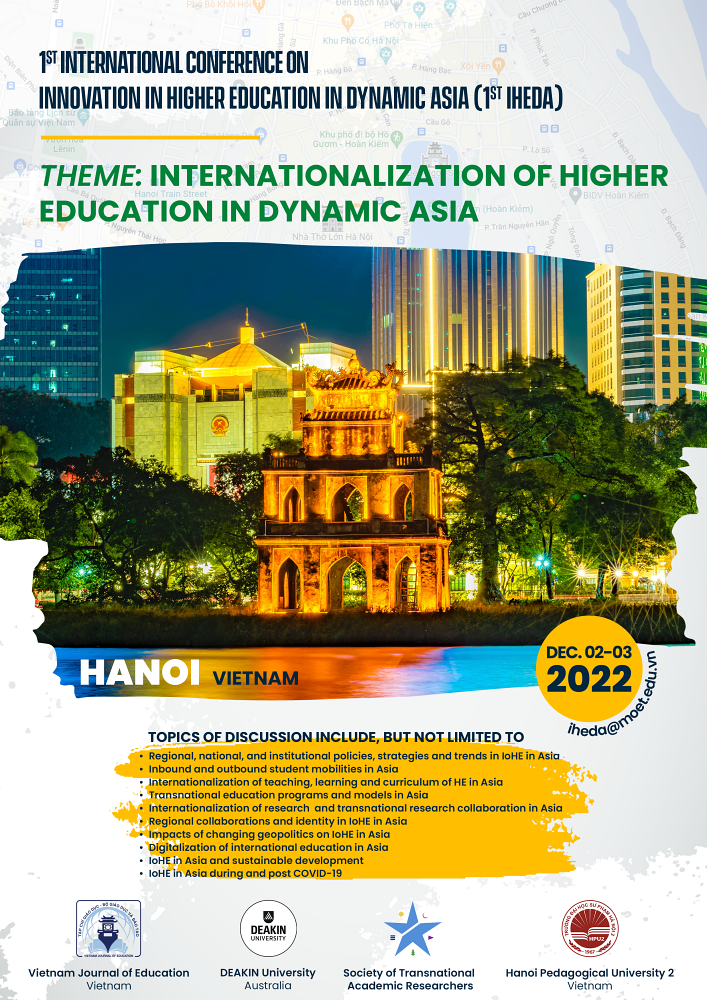Principles of fostering scientific language of Physics by mountainous high school students
DOI:
https://doi.org/10.52296/vje.2020.74-
Downloads
How to Cite
Abstract
Language is an instrument of communication and thinking. During the development of the scientific disciplines, a separate system of language called scientific language has been formed; language of Physics is also formed and plays an important role in the history of Physics. In the context of Vietnamese mountainous students, fostering scientific language in general and Physic language in particular is very necessary; it contributes to the academic success of students by researching documents on fostering language in scientific context, coordinated with characteristics about language and communication of students in mountainous areas in Vietnam. The article introduces 4 principles to learn the language of Physics and an example of planning lessons in teaching Physics to support students in mountainous areas in Vietnam.
Downloads
References
Brookes, D. T. (2006). The role of language in learning Physics. Rutgers University, USA.
Collins, J. B. (2004). Standardizing an Ontology of Physics for Modeling and Simulation. Defense Technical Information Center, Fort Belvoir, VA.
Do Huong Tra (2013). LAMAP - a modern teaching method. University of Education Publishing House.
Evagorou, M. & Osborne, J. (2010). The role of language in the learning and teaching of science. In J. Osborne & J. Dillon (Eds.), Good practice in science teaching: what research has to say (2nd ed.), New York: Open University Press/McGraw-Hill, 135-157.
Exploratorium (2015a). Developing Language in the Context of Science: A View from the Institute for Inquiry. The Institute for Inquiry, accessed from https://www.exploratorium.edu/education/ifi/inquiry-and-eld/educators-guide/conceptual-overview
Exploratorium (2015b). Science Talk: A Tool for Learning Science and Developing Language. The Institute for Inquiry, accessed from https://www.exploratorium.edu/education/ifi/inquiry-and-eld/educators-guide/science-talk
Exploratorium (2015c). Science Writing: A Tool for Learning Science and Developing Language. The Institute for Inquiry, accessed from https://www.exploratorium.edu/education/ifi/inquiry-and-eld/educators-guide/science-writing
FOSSweb (2002). Science-Centered Language Development in Middle School. FOSS for Middle School, NSF Grant ESI-9553600, The Regents of the University of California.
Gibbons, P. (2002). Scaffolding language, scaffolding learning: Teaching second language learners in the mainstream classroom. Portsmouth, NH: Heinemann.
Hawkins, K. T. (2012). Thinking and reading among college undergraduates: An examination of the relationship between critical thinking skills and voluntary reading. Dissertation, University of Tennessee.
Henderson, J. & Wellington, J. (1998). Lowering the language barrier in learning and teaching science. School Science Review, 79(288), 35-46.
Jimenez-Silva, M. & Gomez, C. L. (2011). Developing Language Skills in Science classrooms. Science Activities, 48, 23-28, https://doi.org/10.1080/00368121.2010.495141
Konishi, H. et al. (2014). Six Principles of Language Development: Implications for Second Language Learners. Developmental Neuropsychology, 39(5), 404-420, https://doi.org/10.1080/87565641.2014.931961
Nguyen Thi Thuy (2018). Promoting problem-solving capability for students via the cognitive activities of thermological knowledge in the junior high school curriculum under the view of Lamap. Doctoral Dissertation, Hanoi National University of Education.
Nguyen Van Gioi (2011). Developing communication skills for students of Ha Giang Ethnic Boarding High School. Master thesis, Thai Nguyen University of Education.
Pham Song Ha (2012). Communication characteristics of Muong ethnic middle school students. Doctoral Dissertation, Graduate Academy of Social Sciences.
Pham Thi Ngoc Thang (2003). Improving the teaching quality of the “electromagnetic induction and alternating current” module in ethnic boarding middle schools through fostering problem-solving capabilities for students. Doctoral Dissertation, Hanoi National University of Education.
Redish, E. & Kuo, E. (2015). Language of Physics, Language of Math: Disciplinary Culture and Dynamic Epistemology. Science & Education, 24, 561-590, https://doi.org/10.1007/s11191-015-9749-7
Sutton, C. (1992). Words, science, and learning. Developing science and technology education, Open University Press, Buckingham, Philadelphia, 118.
Sutton, C. (1996). Beliefs about science and beliefs about language. Taylor and Francis Ltd.
Swain, M. (2000). The Output Hypothesis and Beyond: Mediating Acquisition Through Collaborative Dialogue. UK J. Lantolf. Oxford, Sociocultural Theory and Second Language Learning, Oxford University Press, 97-114.
Wellington, J. & Osborne, J. (2001). Language and literacy in science education. Buckingham: Open University Press.
Zubaidah, S. et al. (2018). Revealing the Relationship between Reading Interest and Critical Thinking Skills through Remap GI and Remap Jigsaw. International Journal of Instruction, 11(2), 41-56, https://doi.org/10.12973/iji.2018.1124a




















